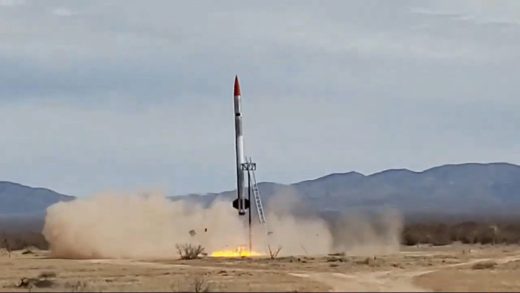A sampling of recent articles, press releases, etc. related to student and amateur CubeSat / SmallSat projects and programs:
** The Virginia CubeSat Constellation involves students at four Virginia universities and is supported by the Virginia Space Grant Consortium. They have developed three CubeSats that will be launched to the ISS on a Cygnus cargo craft and then sent into orbit by a NanoRacks deployment system: Three Virginia University Satellites Get Closer to Launch – Virginia Space Grant Consortium (pdf)
A giant leap towards space for Virginia university students took place on February 26 when students from three Virginia universities delivered their small satellites to NanoRacks in Houston to be integrated into the Company’s commercially developed CubeSat deployer (NRCSD) and then launched on Northrop Grumman’s Antares to the International Space Station.
The satellites are part of the Virginia CubeSat Constellation mission, a collaborative project of the Virginia Space Grant Consortium and four of its member universities: Old Dominion University (ODU), Virginia Tech (VT), University of Virginia (UVA), and Hampton University (HU). Three nano-satellites, each about 4 inches cubed and weighing approximately 3 pounds, have been developed and instrumented (one each at ODU, VT and UVA) to obtain measurements of the properties of the Earth’s atmosphere. As the orbits of the satellites decay due to atmospheric drag, satellite instruments will quantify atmospheric density.
The three CubeSats will be deployed via the NRCSD by astronauts aboard the International Space Station into orbit near-simultaneously so they can orbit together and function as a constellation. The ODU satellite, which has a drag brake to intentionally cause orbital decay, is expected to remain in orbit for up to four months. The other two satellites should orbit for up to two years at an altitude of 250 miles before burning up when they re-enter Earth’s atmosphere. The satellites will communicate data to ground stations at Virginia Tech, University of Virginia and Old Dominion University for subsequent analysis using an analytical tool being developed by Hampton University students from the Atmospheric and Planetary Science Department.
See also

** Cape Peninsula University of Technology (CPUT) has put two cubesats into orbit (ZA Cube-1 and ZACube-2) and is developing a constellation for Maritime Domain Awareness (MDA) and fire detection in the South African grasslands: CPUT receives more investment to build South Africa’s MDA satellite constellation – Space in Africa
The recently announced R27 million investment will fund the CubeSat space program to develop three more nano-satellites for an MDA satellite constellation that will assist South Africa’s ocean monitoring efforts and veld fire detection. The space programme has already graduated over 60 postgraduate students starting from CPUT’s first CubeSat ZACube-1.
See also R27m cash injection for satellite programme | ITWeb.
** CubeSat (STF-1) developed by TMC Technologies with the help of West Virginia University students and supported by the West Virginia Space Grant Consortium was launched in December by Rocket Lab. The project may be the start of a WV smallsat industry: WV could serve as new satellite manufacturing hub – State Journal News/wvnews.com
STF-1 is a cube satellite designed and assembled in North Central West Virginia by Marion County-based TMC Technologies in collaboration with faculty and students at West Virginia University as part of NASA’s Educational Launch of Nanosatellites mission. Launched from New Zealand’s Mahia Peninsula in December, STF-1 recently achieved a milestone of 60 days in space, orbiting the globe more than 960 times.
…
[Project lead engineer Matt Grubb] said that given STF-1’s success, there’s a strong foundation to build upon in terms of infrastructure and experience if a CubeSat manufacturing industry were to take off. One issue that does need to be addressed, he said, is attracting outside scientists and innovators. STF-1 has been successful, but it was largely a feat of engineering and technical prowess. Now, Grubb said, the next big project will have to be more creative to find new instruments or designs to send into orbit.
TMC President and CEO Wade Linger is hoping the success of STF-1 will lead to getting the chance to build more spacecraft in West Virginia.
** AMSAT news on student and amateur CubeSat/smallsat projects: ANS-061 AMSAT News Service Special Bulletin
- Call for Volunteers – AMSAT at Dayton Hamvention
- JAMSAT Announces 2019 Symposium, March 16-17
- SatNOGS Client and gr-satnogs Updates
- ARISS News — Reports Requested
- “Off to the Motherland” Rove
- Activating Northern Maine Grids – March 2-3
- Summer Internship Positions Open in the SpaceSTEM Program
- Virginia Cubesat Constellation Moves Forward
- New ‘NASA Science Live’ Program Premiers This Week
- Satellite Shorts From All Over
General CubeSat/SmallSat info:
- Alba Orbital sell first two Unicorns to Stealth startup Stara Space — Alba Orbital
- First Hawkeye 360 satellites pinpointing signals – SpaceNews.com
- S&T Launches Polar Scout Satellites Using SpaceX Falcon 9 Vehicle – ECNMag.com
- D-Orbit Signs Contract for launch and deployment services with Planet Labs – D-Orbit (pdf)
- Sydney signs deal with Japanese space start-up to deploy CubeSats – The University of Sydney
- CUAVA (Centre for CubeSats, UAVs & their Applications) at University of Sydney
- Small Satellite Technology Being Developed at Ottawa Incubator ‘Greenhouse’ – SpaceQ
- ARISS contact planned for students in Spain | Southgate Amateur Radio News
- Qatar OSCAR-100 web receiver now live | Southgate Amateur Radio News
- Dynamics of a Small-Scale Hydrogen Peroxide Vapor Propulsion System | Journal of Propulsion and Power
- “MarCO: Flight Operations with the First Interplanetary CubeSats” – FISO Telecon Seminar – Andrew Klesh , NASA JPL (Slides pdf)
====









